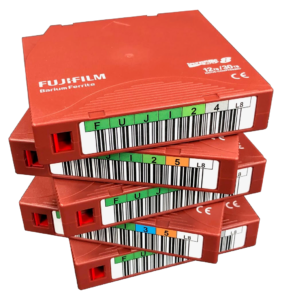In this Executive Q&A, Rich Gadomski, Fujifilm’s Head of Tape Evangelism, discusses the evolution of tape storage and how recent innovations and advancements in tape technology are putting it at center stage.

Explain your role as Tape Evangelist for FUJIFILM Recording Media, U.S.A.
I believe tape technology has a compelling value proposition and a great story to tell. I want to be focused on telling that story and that is my primary role. Of course, it takes a team and we all do our part, but this is what I’m passionate about and want to focus on.
How has the tape storage industry changed over the years?
Tape technology has come a long way since its introduction in the 1950s where we had reel-to-reel tape that could hold just a few megabytes of data. Today we have LTO tape in the market at 12 TB native and enterprise tape at 20TB. Just looking at LTO which came out 20 years ago, it was LTO Gen 1 in 2000 with 100GB of capacity. We expect LTO-9 soon at 18TB so a 180x increase. And just recently we announced a joint demonstration with IBM showing that we can reach up to 580 TB on a single cartridge with our next generation of magnetic particle called Strontium Ferrite. But it’s not just about capacity increases, tape has also made advancements in transfer rate, now faster than HDD, reliability rating, now three or four magnitudes better than HDD and it’s the greenest form of storage consuming far less energy than constantly spinning HDD and this contributes to its lowest total cost of ownership. But today it’s not about tape vs. HDD, in fact, the two technologies complement each other to help customers optimize their data storage.
Why is tape storage still relevant today? What is driving demand for this technology?
I would say first and foremost the incredible amount of data that’s being created in this digital economy. Add to the fact that the value of data is increasing so we want to store more of it for longer periods of time. Yet, IT budgets are flat or barely increasing, so you need a high capacity, highly reliable storage media that is cost-effective for long-term storage and that’s what tape gives you. So tape plays a role in cold archiving, active archiving and yes, backup as well. In fact, tape has renewed interest from customers in the fight against cybercrime and ransomware since customers can easily backup to tape and remove those backups from the network to an isolated and secure location that hackers can’t get to. That’s what we refer to as the tape air gap. Last but not least is energy consumption. Society is rightfully concerned about climate change. Tape consumes 87% less energy than disk and that leads to 87% less CO2 emissions.
How is FUJIFILM Recording Media innovating in the tape storage industry?
FUJIFILM has been the technology leader from our ATOMM coating technology which was the key enabler behind DLT tape to NANOCUBIC coating with Barium Ferrite particles that enabled the first multi-terabyte LTO and enterprise tapes to future particles we are working on such as Strontium Ferrite which will allow hundreds of terabytes on a single cartridge. So we have led the development of areal density which leads to higher capacity and lower cost. And we are innovative at delivering customer satisfaction. Our Bedford Massachusetts factory can customize products and packaging for customers large and small in surprising ways.

Can you explain the future road map for LTO tape from LTO-9 and beyond?
Sure. LTO-9 was recently announced at 18TB native capacity, 45TB compressed. We expect that product to be in the market within the first half of 2021. Then the roadmap extends to Gen 12 at 144 TB native, 360TB compressed. We should see that product on the market before the end of the decade with two to three years typically between generations. And just a reminder, IBM and FUJIFILM demonstrated the potential for 220TB native back in 2015 using Barium Ferrite particles and we announced a new demo of Strontium Ferrite particles at 580TBs so I think the LTO roadmap is achievable and has a promising future.
What is your outlook for the future of tape and the role that FUJIFILM Recording Media will play?
We are well into the zettabyte age for data storage requirements with total capacity shipped of all storage types exceeding one zettabyte in 2019 for the first time. Analysts predict we’ll need to be storing 7.5 zettabytes of persistent data by 2025. We will need a lot of very high capacity tapes and HDD for that matter if this is true and I believe it is. IT leaders will be challenged by the need to store more data for longer periods of time and to do it with high capacity media, cost-effectively, securely and in an environmentally friendly manner. The successful strategies will be about storage optimization, active archiving and tiering. Getting the right data, in the right place, at the right time. Tape is playing a role now in the successful strategies of some of world’s largest and most sophisticated storage consumers and will continue to do so. As far as FUJIFILM Recording Media is concerned, we’ll continue to innovate in customer satisfaction and in areal density achievements!
